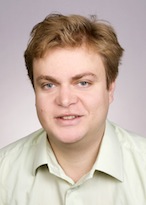Dr. Ivan ChakalovUniversitätsmedizin Göttingen E-mail: chakalov.ivan@googlemail.com |
 |
PhD in 2014
Dr. Ivan ChakalovUniversitätsmedizin Göttingen E-mail: chakalov.ivan@googlemail.com |
 |
PhD in 2014
Neuroimaging of primary and schema-based auditory stream segregation, involving peripheral and central neuronal mechanisms
The ability of humans and animals to focus their attention on a single sound source among other surrounding sounds and background noises was described in the framework of the well-known “cocktail party effect”. Auditory Scene Analysis (ASA) is a widely accepted cognitive model concerned with resolving the “cocktail party effect” (Bregman AS 1990). The model explains the perceptual organization of sounds based on the main principles of Gestalt psychology. These principles include perceptual-segregation of acoustical patterns into separated sound-streams also known as “stream-segregation” or “fission”, and the complementary process, the perceptual-integration of sound-streams into one unified auditory object, also known as “stream integration” or “fusion”. Despite of the general knowledge about the psychophysical bases of ASA, its neural underpinnings are still poorly understood. My project investigated the neural correlates of auditory scene analysis by introducing novel perceptual paradigms in three different studies published in peer-review scientific journals. Magnetoencephalography (MEG) was used to explore the neural effects in the three experiments. The three studies propose advanced techniques and experimental paradigms for analysis of various aspects of auditory perception and their underlying neural mechanisms via different neuroimaging techniques.
Prof. Dr. Christo Pantev , Institute for Biomagnetism and Biosignalanalysis, WWU Münster, Supervisor
Prof. Dr. Norbert Sachser, Institute of Psychology, WWU Münster
Prof. Dr. Markus Lappe , Department Of Behavioural Biology, WWU Münster
Chakalov I, Paraskevopoulos E, Wollbrink A, Pantev C. 2014 Mismatch negativity to acoustical illusion of beat: what and where change detection takes place? NeuroImage, DOI: 10.1016/j.neuroimage.2014.06.026. Web.
Chakalov I, Draganova R, Wollbrink A, Preissl H, Pantev C. 2013. Perceptual organization of auditory streaming-task relies on neural entrainment of the stimulus-presentation rate: MEG evidence.
BMC Neuroscience 14:120-2202-14-120. Web.
Chakalov I, Draganova R, Wollbrink A, Preissl H, Pantev C. 2012. Modulations of neural activity in auditory streaming caused by spectral and temporal alternation in subsequent stimuli: A magnetoencephalographic study.
BMC Neuroscience 13:72-2202-13-72. Web.
Chakalov I, Wollbrink A, Pantev C. Perceptual organization of sequential auditory objects relies on oscillatory entrainment of the stimulus presentation rate: MEG evidence. Poster presentation at Neurovisionen – 9 (Neuro NRW), 29 November 2013, Köln, Germany
Chakalov I, Draganova R, Wollbrink A, Preissl H, Pantev C. Modulations of neural activity in auditory streaming induced by spectral and temporal alternations of the prior stimuli: an MEG study. Poster Presentation at 18th International Conference on Biomagnetism - Biomag 2012, 26-30 August 2012, Paris, France
Chakalov I, Draganova R, Wollbrink A, Preissl H, Pantev C. Neural bases of auditory stream segregation: magnetoencephalographic study. Poster Presentation at Lifelong Learning conference Tübingen, 25-27 November 2010, Tübingen, Germany
| 06/2010-06/2014 | Research associate, Institute for Biomagnetism and Biosignalanalysis -Muenster, Westfälische Wilhelms Universität - Münster, Germany. Working on a research project “Neuroimaging of primary and schema-based auditory stream segregation, involving peripheral and central neuronal mechanisms”, funded by Deutsche Forschungsgemeinschaft (German Research Foundation), DR 807/1-1. |
| *1984 | Sofia, Bulgaria |
| 09/2003-03/2010 | MD, Medical University – Sofia, Faculty of Medicine, Sofia, Bulgaria |
| 2010 | Beginning of PhD research project, Institute for Biomagnetism and Biosignalanalysis, University Hospital Münster, WWU Münster |